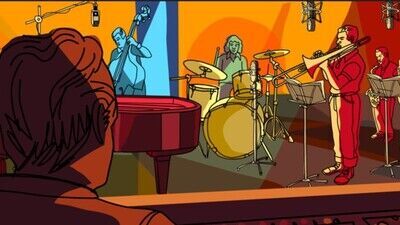Trueba has said in interviews that he didn’t instantly settle on animation as the movie’s format, but gravitated toward it after working on the 2010 animated romantic drama “Chico and Rita” with artist Javier Marsical, his collaborator on many projects (including record albums; Trueba, who did the great Latin jazz documentary “Calle 54,” is also a music producer). There wasn’t much in the way of photos or motion picture footage to tell Tenorio’s story, and Trueba didn’t want the movie to be two hours of people sitting in chairs. He wanted to be able to envision Tenorio playing music and living his life. The result is a lavishly colorful, widescreen-format, animated hybrid of the music documentary, the political primer, and the “Citizen Kane”-like linear biography of an artist, with a journalist figure serving as our guide.
The latter aspect is where the film falls short—or perhaps one should say that it limits itself. Jeff Goldblum, who happens to be an absolute beast of a jazz pianist on top of his acting, plays an invented New Yorker writer from Brooklyn named Jeff Harris who tells a book-signing audience about how he found out about Tenorio while writing a book on bossa nova music and ended up traveling through Latin America interviewing family, friends, colleagues and music experts about the pianist’s life, work, and disappearance. It’s easy to imagine a more straightforward “documentary” version being assembled from the same basic materials—including twenty years’ worth of interviews by Trueba with people talking about Tenorio, the music scene in Latin America in the ‘70s, the rise of authoritarianism, the terroristic tactic of “disappearing” people, and other relevant subjects—without the Jeff Harris character. (It appears that in some cases, Trueba has replaced audio of himself asking questions and responding to interviewees with Goldblum.)
That having been said, Goldblum’s vocal performance is naturalistic and witty (he talks like a jazz pianist plays, never attacking the melody in quite the way you expect), and the conceit of having an “interviewer” who is essentially a stand-in for Trueba lets the story hop amongst many different types of personal spaces. as one might in a regular documentary. Trueba and Marsical fill every frame with massive amounts of information. You’ll enjoy letting your eye roam around the backgrounds and notice certain books, posters, photos, paintings, and stray bits of action that had to be drawn just like everything else in the movie but feel somehow “caught on camera” (such as a dog briefly glimpsed through the open doorway of a bar, or a man in the background of an outdoor plaza taking a piece of fruit from a stand). It’s a kick to see the same journalistic approach to characterization applied in an animated setting: letting the accumulated details tell you who a person is.

